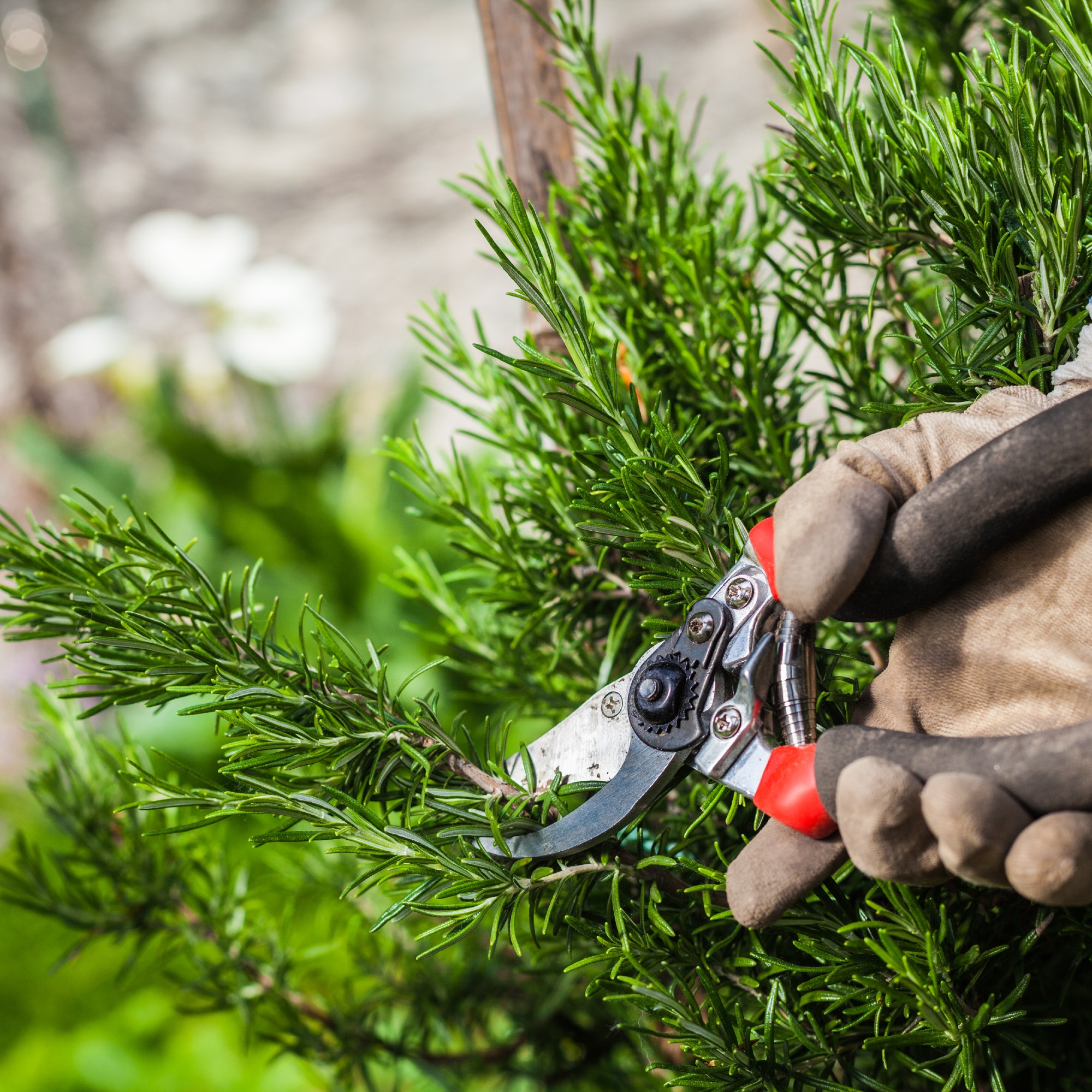
When it comes to herbs, rosemary is one of the first that springs to mind – it's hardy, easy to grow and smells delicious. Learning how to prune rosemary will encourage your healthiest plants yet.
If you've already figured out how to grow rosemary, you'll know how useful it is to have on-side. Once you establish when to cut rosemary back, your plants will be on their way to healthier growth season after season.
A brilliant option for drought-tolerant garden ideas, rosemary originates from the Mediterranean and provides silvery green leaves which are perfect for flavouring meat and vegetables.
We asked garden experts how to prune rosemary to help you get the most out of your plants.
1. Choose the right equipment
To begin with, you'll need to make sure you have the right kit. Knowing how to clean garden tools properly will ensure you aren't spreading diseases between plants.
'All you need is a pair of clean, sharp pruning shears or scissors,' says Claire Hooper, plant area manager at Hillier Garden Centres in Winchester. 'Ensuring your tools are clean helps prevent the risk of disease.'
While hygiene is paramount, the quality of your tools is important, too. 'Make sure the shears haven’t gone blunt so you can easily tackle the thicker branches,' advises Chris Bonnett, owner of Gardening Express. 'The sharper, the better when handling stubborn stems. Always remember to wear suitable garden gloves to ensure you’re protected from any potential injuries.'
Here are our top picks:
A handy garden trug to catch your clippings while you prune.
2. Avoid woody stems
Before you begin, it's important to make sure you know which parts of the plant you should be cutting, and which growth you should leave alone.
'Do not cut into the old, woody stems, as these do not regenerate well,' advises Kate Turner, gardening guru at Miracle-Gro. 'Instead, focus on the newer, green growth.'

3. Know how much to cut back
Knowing how far back you can cut rosemary will ensure you aren't causing unnecessary damage to the plant.
'Cut the plant back by about a third, keeping it bushy and rounded to encourage more branching and shape,' says Claire from Hillier Garden Centres. 'If your rosemary plant is large, prune it in stages to keep it even and manageable.'
Pruning too much at once can also shock the plant, so less is often more if you want to keep your rosemary in good condition. You can lightly trim rosemary throughout the growing season to help maintain its shape.
4. Remove dead or damaged branches
Check the shrub over for dead or damaged branches. 'Remove any dead or diseased parts to help the plant direct its energy towards healthy growth,' says Claire.
If you're wondering where to make the cuts, there's a simple rule you can follow. 'When trimming, make your cuts just above a leaf node or side branch to encourage new growth,' advises Kate from Miracle-Gro.
You should also cut away any overgrowth, focusing on areas where the plant is dense enough to block airflow. It's a good idea to remove low-lying branches that touch the ground, too.

5. Aftercare
Now you know how to prune rosemary, you might be after some aftercare tips.
'Water the plant well after a heavy pruning session to help it recover and stimulate new growth,' says Kate from Miracle-Gro.
It's also important to collect the trimmings and dispose of them to prevent potential diseases from spreading to your plants.

FAQs
Why is my rosemary so woody?
'Rosemary tends to become woody when not regularly pruned to encourage softer, new growth,' explains Angela Slater from Hayes Garden World. 'Like lavender, it's a woody shrub with a relatively short lifespan, typically needing replacement every decade or so.
'Pruning into old wood isn't effective, so if you allow your rosemary to become excessively woody, it will eventually appear straggly with only sparse new growth at the tips.'
How do you cut rosemary so it keeps growing?
Pruning your rosemary plant every year will encourage healthy new growth, but it's important to keep the plant's natural lifespan in mind.
'Regular trimming will keep your rosemary bushy for longer, with plenty of young growth lower down,' says Annelise Brilli, horticultural expert at Thompson & Morgan. 'However, over time, the point where you can make your cuts will become higher and higher as the older stems become thicker and less productive.
'The shrub will eventually develop into a straggly bush with all the new growth carried on the ends of bare stems. Although regular trimming will delay this, all plants will reach this stage as they age. At this point, your only option is to purchase a new specimen or grow replacement plants from cuttings.'
Can a brown rosemary plant be revived?
'If your rosemary plant has turned brown, it’s time to replace it,' says Alasdair Moore, head of gardens and estate at The Lost Gardens of Heligan in Cornwall. 'Regular pruning should help keep your plant healthy, but if it’s struggling to grow then I would look at the growing site – is it well drained with enough direct sunlight? Unsuitable conditions may cause fungal diseases such as root rot, causing the stems to turn brown and die.'
Now you know how to prune rosemary, you'll garner healthier plants for happier pickings.







